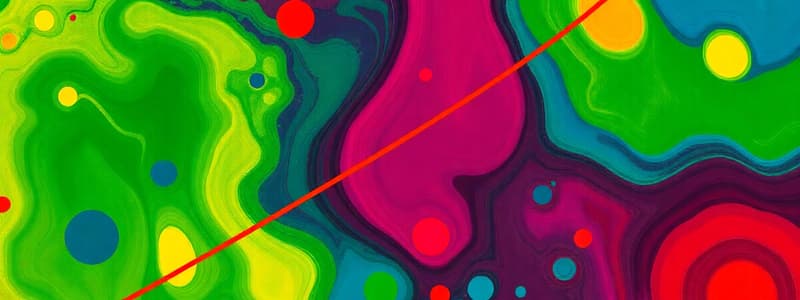Podcast
Questions and Answers
What characterizes exponential growth in a population?
What characterizes exponential growth in a population?
- It reflects a maximum environment support capacity.
- Population size remains constant over time.
- It is described by a J-curve. (correct)
- It assumes limited resources are available.
What is the primary focus of logistic growth models?
What is the primary focus of logistic growth models?
- Maximizing the use of unlimited resources.
- Ignoring density-dependent factors.
- Incorporating limiting resources and carrying capacity. (correct)
- Population declines exponentially over time.
Which of the following factors is NOT considered a density-dependent factor?
Which of the following factors is NOT considered a density-dependent factor?
- Food availability
- Natural disasters (correct)
- Disease spread
- Competition for mates
What happens during an overshoot in a population's growth?
What happens during an overshoot in a population's growth?
What does biotic potential represent in population growth models?
What does biotic potential represent in population growth models?
Which reproductive strategy is associated with species that typically produce few offspring but invest significant resources in their care?
Which reproductive strategy is associated with species that typically produce few offspring but invest significant resources in their care?
What characteristic primarily describes a population pyramid indicative of rapid growth?
What characteristic primarily describes a population pyramid indicative of rapid growth?
Which demographic parameter is often used to compare the health and longevity of populations in different countries?
Which demographic parameter is often used to compare the health and longevity of populations in different countries?
What is the primary difference between r-selected and K-selected species in terms of their reproductive success?
What is the primary difference between r-selected and K-selected species in terms of their reproductive success?
Which of the following best describes the infant mortality rate in developed countries compared to developing countries?
Which of the following best describes the infant mortality rate in developed countries compared to developing countries?
What shape of an age structure diagram typically indicates a declining population size?
What shape of an age structure diagram typically indicates a declining population size?
Which equation would you use to determine the growth rate of a population based on crude birth and death rates?
Which equation would you use to determine the growth rate of a population based on crude birth and death rates?
What is a significant socioeconomic factor affecting population parameters?
What is a significant socioeconomic factor affecting population parameters?
How is the Crude Death Rate (CDR) calculated?
How is the Crude Death Rate (CDR) calculated?
What effect does access to quality healthcare commonly have on population growth?
What effect does access to quality healthcare commonly have on population growth?
How is the growth rate calculated when using crude rates?
How is the growth rate calculated when using crude rates?
What does the 'Rule of 70' help determine in population dynamics?
What does the 'Rule of 70' help determine in population dynamics?
Which factor is NOT typically considered a socioeconomic influence on demographic parameters?
Which factor is NOT typically considered a socioeconomic influence on demographic parameters?
What is net migration defined as?
What is net migration defined as?
Which of the following is considered a demographic parameter influenced by social bias?
Which of the following is considered a demographic parameter influenced by social bias?
Which stage of demographic transition is characterized by a high crude birth rate and high crude death rate?
Which stage of demographic transition is characterized by a high crude birth rate and high crude death rate?
What type of age structure diagram is most commonly associated with Stage 4 of demographic transition?
What type of age structure diagram is most commonly associated with Stage 4 of demographic transition?
In which stage of demographic transition would you expect to see an overall population size that is highest but potentially decreasing?
In which stage of demographic transition would you expect to see an overall population size that is highest but potentially decreasing?
During which stage of demographic transition does the growth rate transition from high to lower levels?
During which stage of demographic transition does the growth rate transition from high to lower levels?
What happens to the birth rate as a society progresses from Stage 2 to Stage 3 in demographic transition?
What happens to the birth rate as a society progresses from Stage 2 to Stage 3 in demographic transition?
Which stage of population growth is characterized by increased access to healthcare and education?
Which stage of population growth is characterized by increased access to healthcare and education?
In which phase of population growth would you observe the most rapid population increase?
In which phase of population growth would you observe the most rapid population increase?
What socioeconomic trend is associated with Stage 1 of population growth?
What socioeconomic trend is associated with Stage 1 of population growth?
Which type of survivorship curve typically describes human populations?
Which type of survivorship curve typically describes human populations?
What demographic characteristic is observed in Stage 4 populations, such as those in Japan and Germany?
What demographic characteristic is observed in Stage 4 populations, such as those in Japan and Germany?
Which phase of population growth is characterized by stable population growth?
Which phase of population growth is characterized by stable population growth?
In which phase of population growth are birth and death rates initially high before decreasing?
In which phase of population growth are birth and death rates initially high before decreasing?
Which of the following countries is an example of a Phase 4 population growth context?
Which of the following countries is an example of a Phase 4 population growth context?
What significant change occurs in the birth and death rates as a population transitions from Phase 1 to Phase 2?
What significant change occurs in the birth and death rates as a population transitions from Phase 1 to Phase 2?
What is a common characteristic of populations in Phase 1 of the growth model?
What is a common characteristic of populations in Phase 1 of the growth model?
Flashcards
Exponential Growth
Exponential Growth
Population growth where the rate of increase is proportional to the current size of the population, assuming unlimited resources.
Density-Dependent Factor
Density-Dependent Factor
A factor that limits a population's growth as density increases.
Density-Independent Factor
Density-Independent Factor
A factor that limits a population's growth regardless of its density.
Logistic Growth
Logistic Growth
Signup and view all the flashcards
Carrying Capacity
Carrying Capacity
Signup and view all the flashcards
Type I survivorship curve
Type I survivorship curve
Signup and view all the flashcards
r-selected species
r-selected species
Signup and view all the flashcards
K-selected species
K-selected species
Signup and view all the flashcards
Type III survivorship curve
Type III survivorship curve
Signup and view all the flashcards
Total Fertility Rate (TFR)
Total Fertility Rate (TFR)
Signup and view all the flashcards
Population Pyramid
Population Pyramid
Signup and view all the flashcards
Stable Population
Stable Population
Signup and view all the flashcards
Crude Birth Rate (CBR)
Crude Birth Rate (CBR)
Signup and view all the flashcards
Rule of 70
Rule of 70
Signup and view all the flashcards
Crude Death Rate (CDR)
Crude Death Rate (CDR)
Signup and view all the flashcards
Growth Rate Calculation
Growth Rate Calculation
Signup and view all the flashcards
Crude Rates
Crude Rates
Signup and view all the flashcards
Net Migration
Net Migration
Signup and view all the flashcards
Doubling Time
Doubling Time
Signup and view all the flashcards
Demographic Transition
Demographic Transition
Signup and view all the flashcards
Stage 1: Pre-industrial
Stage 1: Pre-industrial
Signup and view all the flashcards
Stage 2: Industrializing/Transitional
Stage 2: Industrializing/Transitional
Signup and view all the flashcards
Stage 3: Industrialized
Stage 3: Industrialized
Signup and view all the flashcards
Stage 4: Post-industrial
Stage 4: Post-industrial
Signup and view all the flashcards
Age Structure Diagram
Age Structure Diagram
Signup and view all the flashcards
Population Growth Stages
Population Growth Stages
Signup and view all the flashcards
Phases of Population Growth
Phases of Population Growth
Signup and view all the flashcards
Age Pyramid
Age Pyramid
Signup and view all the flashcards
Phase 2: Industrializing
Phase 2: Industrializing
Signup and view all the flashcards
What are the four stages of population growth?
What are the four stages of population growth?
Signup and view all the flashcards
Study Notes
Population Ecology (AP Topics 3.1-3.5)
- Activities for the topic include demonstrations with balls or rolling pins, examining exponential and logistic growth models and cards identifying K- vs r-selection. Labs and assignments on the topic, including human survivorship curves, are also available.
Population Growth Dynamics
- Population growth models
- Exponential growth assumes unlimited resources. Population growth is determined by the biotic (intrinsic) growth rate, which is the maximum possible growth rate. The curve shaped of this model can be described as a J-curve.
- Logistic growth incorporates limiting resources and carrying capacity (the maximum population size that an environment can support). This population growth model shows an S-curve.
Factors Limiting Population Growth
- Density-dependent factors influence individual survival probability.
- Density-independent factors influence individual survival probability.
- Impacts of resource availability result in overshoots and diebacks in population growth.
Studying That Suits You
Use AI to generate personalized quizzes and flashcards to suit your learning preferences.




